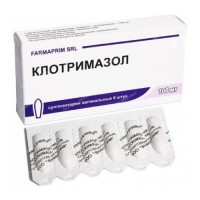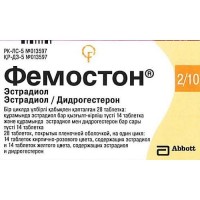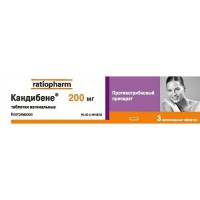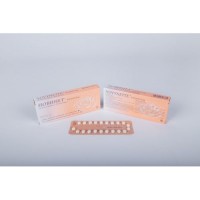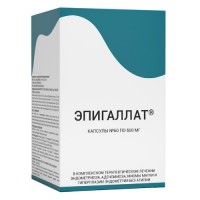Yaz® (Drospirenone/Ethinyl Estradiol) 28 film-coated tablets
- $40.30
Sku:
faffb06f45bf
Brand:
Bayer Weimar (Germany)
Structure
One active tablet contains
active substances: drospirenone 3 mg
ethinylestradiol 0.02 mg,
excipients: lactose monohydrate, corn starch, magnesium stearate,
shell composition: hypromellose, talc, iron (III) oxide red (E172), titanium dioxide (E171).
Indications for use
- oral contraception
The appointment of Yaz also has a positive effect on hormone-dependent fluid retention and related symptoms in women.
- treatment of moderate acne in women requiring hormonal contraception
- treatment of premenstrual dysphoric disorder (a severe form of premenstrual syndrome) in women who need hormonal contraception
Method of administration and dosage
When taken correctly and regularly, combined oral contraceptives have contraceptive reliability, with a “method failure” rate of no more than 1% per year. Contraceptive reliability may be reduced if pills are missed or taken incorrectly.
Yaz tablets should be taken orally in the order indicated on the package, every day at about the same time with a little water. Take one tablet a day continuously for 28 days. Reception of each next package begins the next day after taking the last tablet from the previous package. Menstrual bleeding usually begins on days 2-3 of the inactive pill and may not end until the next pack is started.
How to start taking
- in the absence of taking any hormonal contraceptives in the previous month
Reception begins on the first day of the menstrual cycle (i.e. the first day of menstrual bleeding). It is allowed to start taking on days 2-5 of the menstrual cycle, but in this case it is necessary to additionally use a barrier method of contraception during the first 7 days of taking the pills from the first package.
- when switching from combined hormonal contraceptives (combined oral contraceptive, vaginal ring, transdermal patch)
It is preferable to start taking the next day after taking the last hormone-containing tablet from the previous package, but in no case later than the next day after the usual 7-day break in taking (for preparations containing 21 tablets) or after taking the last non-hormone-containing tablet (for preparations containing 28 tablets per pack). When switching from a vaginal ring or transdermal patch, it is preferable to start on the day the ring or patch is removed, but in no case later than the day when the next ring or patch was to be applied.
- when switching from contraceptives containing only gestagens (mini-pills, injectable forms, implant) or a progestogen-releasing intrauterine system (IUD)
A woman can switch from a mini-drink to Yaz any day (without a break), from an implant or an IUD with a gestagen - on the day of its removal, from an injection form - from the day the next injection was to be made. In all cases, it is necessary to use an additional barrier method of contraception during the first 7 days of taking the pills.
- after an abortion in the first trimester of pregnancy
The woman can start taking the drug immediately. If this condition is met, a woman does not need additional contraceptive protection.
- after childbirth or abortion in the second trimester of pregnancy
The woman should be advised to start taking the drug 21-28 days after childbirth or abortion in the second trimester of pregnancy. If the reception is started later, it is necessary to use an additional barrier method of contraception during the first 7 days of taking the pills. However, if a woman has already had sexual activity, pregnancy should be excluded before the start of admission, or it is necessary to wait for the first menstruation.
Taking missed pills
Missed inactive tablets can be ignored. However, they should be destroyed in order not to accidentally extend the period of taking inactive tablets. The following recommendations apply only to skipping hormone-containing pills.
If the delay in taking the pill is less than 24 hours, the contraceptive protection is not reduced. The woman should take the pill as soon as possible, the next one is taken at the usual time.
If the delay in taking the pills is more than 24 hours, contraceptive protection may be reduced. In this case, you can be guided by the following two basic rules:
• The drug intake should never be interrupted for more than 7 days (it should be borne in mind that the interval between inactive pills is 4 days).
• 7 days of continuous pill intake is required to achieve adequate suppression of the hypothalamic-pituitary-ovarian system.
Accordingly, the following tips can be given if the delay in taking the pills is more than 12 hours (the interval since taking the last pill is more than 36 hours):
1st to 7th day:
A woman should urgently take the last missed pill (even if it means taking two pills at the same time). Next tablet is taken at the usual time. Additionally, a barrier method of contraception (such as a condom) must be used for the next 7 days. If sexual intercourse took place within a week before skipping pills, the likelihood of pregnancy must be taken into account.
The more pills are missed and the closer they are to the hormone-free white pill phase, the higher the chance of pregnancy.
8th to 14th day:
A woman should urgently take the last missed pill (even if it means taking two pills at the same time). The next pill is taken at the usual time.
If the woman took the pills correctly within 7 days prior to the first missed pills, there is no need to use additional contraceptive measures. Otherwise, as well as if you miss more than one pill, you must additionally use barrier methods of contraception (for example, a condom) for 7 days.
From 15th to 24th day:
In connection with the approaching phase of taking hormone-free pills, the risk of a decrease in contraceptive reliability is inevitable. However, the weakening of contraceptive protection can still be prevented by adjusting the pill schedule. Therefore, adhering to one of the two proposed schemes below, you can do without additional measures of protection, provided that within 7 days before the first tablet was missed, the woman took all the tablets correctly. Otherwise, she should be advised to use the first of the following regimens and, in parallel, use additional methods of contraception for 7 days.
1. A woman should urgently take the last missed pill, even if it means that she will have to take two pills at the same time. Then she continues to take the pills at the usual time until the light pink pills run out. The four hormone-free white pills should be thrown away and taken immediately from the next pack. It is unlikely that a woman's withdrawal bleeding will occur before the hormone-containing light pink pills in the second pack run out, but spotting and breakthrough bleeding may occur while taking the pills.
2. The woman can also stop taking the light pink pills from the current package. Then she should take a break for 4 days, including the day of missing pills, and then start taking a new pack.
If a woman has missed pills and does not have withdrawal bleeding while taking hormone-free white pills, the likelihood of pregnancy should be considered.
Tips for Gastrointestinal Disorders
In severe gastrointestinal disorders, absorption of the drug may be incomplete. In this case, additional contraceptive measures should be taken.
If a woman vomits within 3-4 hours after taking hormone-containing pills of light pink color, it is necessary to focus on advice on skipping pills. If a woman does not want to change the normal regimen of taking the drug, she must take an additional tablet (several tablets) from another package if necessary.
Changing the day of the start of the menstrual cycle
In order to delay the onset of menstruation, the woman should continue taking the pills from the next Yaz pack, skipping the hormone-free white pills from the current pack. Thus, the cycle can be extended, if desired, for any period until the hormone-containing light pink pills from the second package run out. While taking the drug from the second package, a woman may experience spotting or breakthrough uterine bleeding. Regular pill intake is then resumed after the end of the hormone-free white pill phase.
To postpone the onset of menstruation to some other day from the day of the week on which withdrawal bleeding usually begins with the current regimen, it is recommended to shorten the next phase of taking hormone-free white tablets by the desired number of days. The shorter this interval, the higher the risk that a woman will not have withdrawal bleeding, and while taking the pills from the second package, she will have breakthrough bleeding or spotting (as with delaying the onset of menstruation).
Side effects
The most common side effects of the drug when used for contraception and in the treatment of moderate acne in women who need hormonal contraception are: nausea, pain in the mammary glands, irregular uterine bleeding, bleeding from the genital tract of an unspecified nature. They met with a frequency of ≥3%.
The most common side effects when using the drug for the treatment of premenstrual dysphoric disorder in women who need hormonal contraception are: nausea, pain in the mammary glands, irregular uterine bleeding. They met with a frequency of> 10%. Serious adverse reactions include arterial and venous thromboembolism.
Often (1 / 100, 1 / 10)
- emotional lability, depression, decreased mood
- nausea
- migraine
- pain in the mammary glands, irregular uterine bleeding, bleeding from the genital tract of an unspecified nature
Uncommon (1 / 1,000, 1 / 100)
- decrease and loss of libido
Rarely (1 / 10,000, 1 / 1000)
- venous or arterial thromboembolic processes (with a frequency as with other oral contraceptives, including occlusion of peripheral deep veins, thrombosis and embolism / occlusion of pulmonary vessels, thrombosis / embolism / myocardial infarction, cerebral infarction and non-hemorrhagic stroke
With an unknown frequency (identified during post-marketing observations)
- erythema multiforme
Description of selected adverse reactions
Adverse reactions with a very low frequency or with a delayed onset of symptoms, which are considered as possibly related to drugs in the combined oral contraceptive group, are listed below:
Tumors
- The incidence of breast cancer diagnosis is slightly increased among women taking oral contraceptives. Because breast cancer is rare in women under 40, the increase in diagnoses is small relative to the overall risk of developing the disease. Its connection with the use of combined oral contraceptives has not been proven.
- liver tumors (benign and malignant)
Other conditions
- erythema nodosum
- women with hypertriglyceridemia have an increased risk of pancreatitis when using combined oral contraceptives
- arterial hypertension
- the appearance or worsening of conditions for which the relationship with the use of combined oral contraceptives has not been proven: jaundice and / or pruritus associated with cholestasis; the formation of stones in the gallbladder; porphyria; systemic lupus erythematosus; hemolytic uremic syndrome; chorea; herpes of pregnant women; hearing loss associated with otosclerosis.
- in women with hereditary angioedema, exogenous estrogens can provoke or exacerbate the symptoms of this disease
- liver dysfunction
- changes in glucose tolerance or the effects of peripheral insulin resistance
- Crohn's disease and ulcerative colitis
- chloasma
- hypersensitivity reactions (including symptoms such as rash and hives)
Interactions
Interactions with other drugs (liver enzyme inducers, some antibiotics) can lead to breakthrough uterine bleeding or a decrease in contraceptive reliability.
Contraindications
Combined oral contraceptives should not be used if you have any of the conditions listed below. If any of these conditions develop for the first time while taking, the drug should be discontinued immediately.
- hypersensitivity to any component of the drug
- thrombosis / thromboembolism (venous and arterial) at present
time or history (eg, deep vein thrombosis, thromboembolism
pulmonary artery, myocardial infarction) or cerebrovascular
violations
- conditions preceding thrombosis (for example, transient
ischemic attacks, angina pectoris) at present or in
anamnesis
- migraine with a history of focal neurological symptoms
- diabetes mellitus with vascular complications
- the presence of multiple or pronounced risk factors for venous or
arterial thrombosis
- severe liver disease (as long as the indicators of function
the liver will not return to normal)
- severe renal failure or acute renal failure
- liver tumors (benign or malignant) in
present or history
- identified hormone-dependent malignant diseases (for example,
genitals or mammary glands) or suspicion of them
- vaginal bleeding of unknown origin
- pregnancy or suspicion of it
Drug interactions
The interaction of oral contraceptives with other drugs (drugs that induce liver enzymes, some antibiotics) can lead to breakthrough bleeding and / or a decrease in the contraceptive effectiveness of the drug. While taking such drugs, the woman should additionally use a barrier method of contraception in addition to Yaz, or choose another method of contraception. While taking drugs that affect microsomal enzymes, and within 28 days after their cancellation, you should additionally use a barrier method of contraception.
While taking antibiotics (with the exception of rifampicin and griseofulvin) and within 7 days after their cancellation, you should additionally use a barrier method of contraception.
If the period of using the barrier method of contraception from unwanted pregnancies ends later than the hormone-containing tablets (light pink) in the package, the inactive white tablets should be skipped and the next package Yazshould be started.
Substances that reduce the effectiveness of combined hormonal contraceptives (inducers of liver enzymes and antibiotics)
Liver enzyme inducers (increased hepatic metabolism) The use of drugs that induce liver microsomal enzymes can lead to an increase in the clearance of sex hormones. These drugs include: phenytoin, barbiturates, primidone, carbamazepine, and rifampicin; there are also suggestions for oxcarbazepine, topiramate, felbamate, ritonavir and griseofulvin and preparations containing St. John's wort.
In addition, HIV protease inhibitors (eg ritonavir) and non-nucleoside reverse transcriptase inhibitors (eg nevirapine), and combinations thereof, have the potential to increase hepatic sex hormone metabolism.
Antibiotics (effects on intestinal-hepatic circulation)
According to some clinical studies, certain antibiotics (for example, penicillins and tetracyclines) can reduce intrahepatic estrogen circulation, thereby lowering the concentration of ethinyl estradiol.
Substances affecting the metabolism of combined hormonal contraceptives (enzyme inhibitors)
The main metabolites of drospirenone are formed without the involvement of the cytochrome P 450 system. Thus, it is unlikely that inhibitors of this enzymatic system can affect the metabolism of drospirenone.
The effect of combined oral contraceptives on other drugs:
Oral contraceptives can affect the metabolism of some other drugs, which leads to an increase (for example, cyclosporine) or a decrease (for example, lamotrigine) their concentration in blood plasma and tissues.
Based on the results of in vitro inhibition studies and in vivo interactions among volunteers who used omeprazole, simvastatin and midazolam as marker substrates, the effect of drospirenone at a dose of 3 mg on the metabolism of other drugs is unlikely.
Other forms of interaction
There is a theoretical possibility of increasing serum potassium levels in women receiving hormone-containing Yaztablets (light pink) concurrently with other drugs that may increase serum potassium levels. These drugs include angiotensin-II receptor antagonists, potassium-sparing

